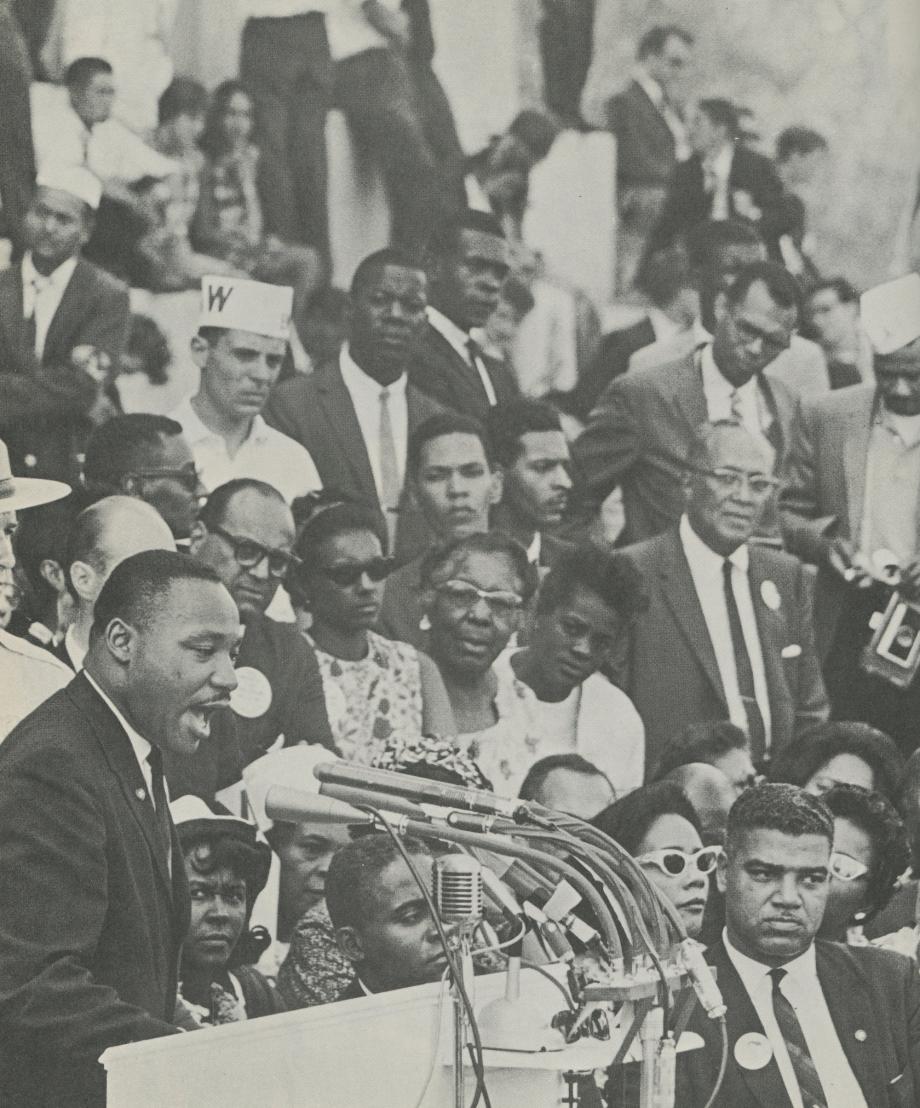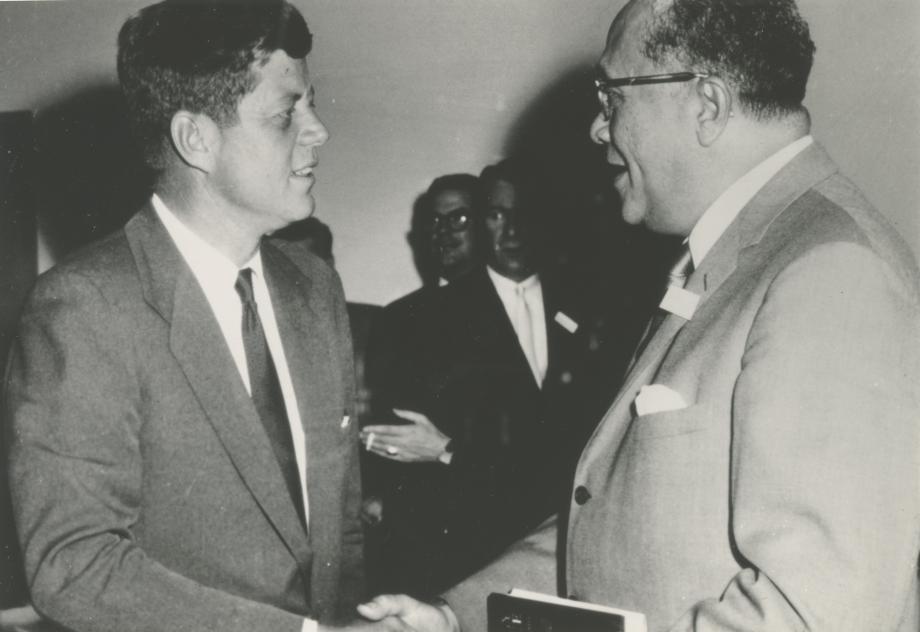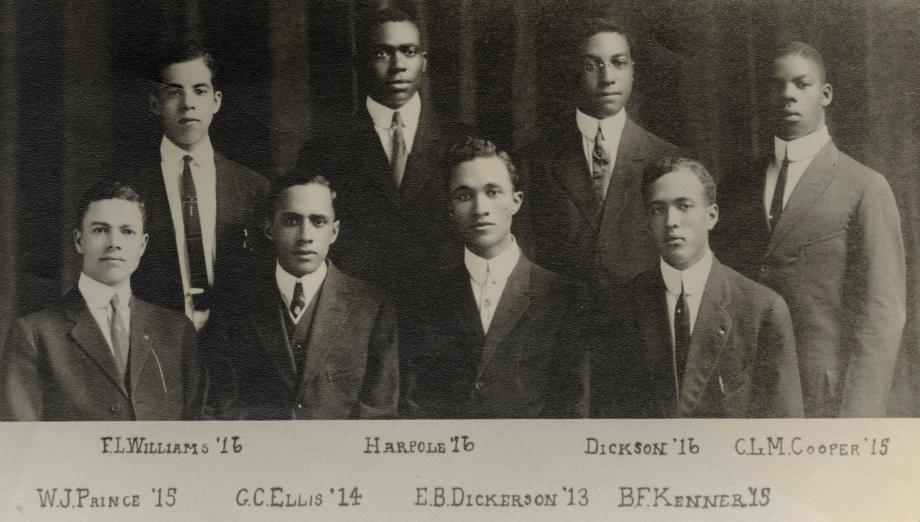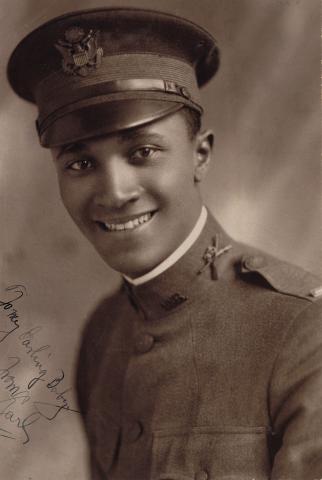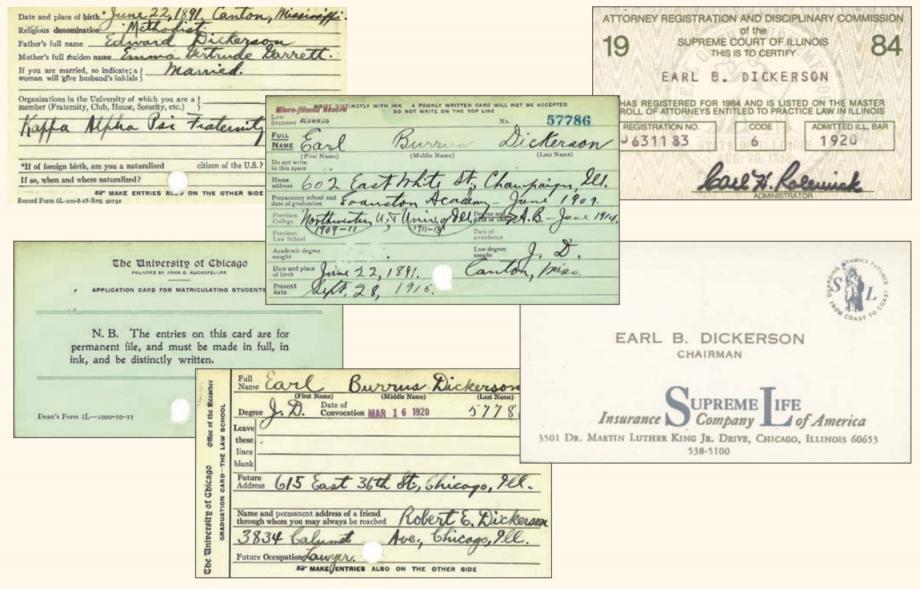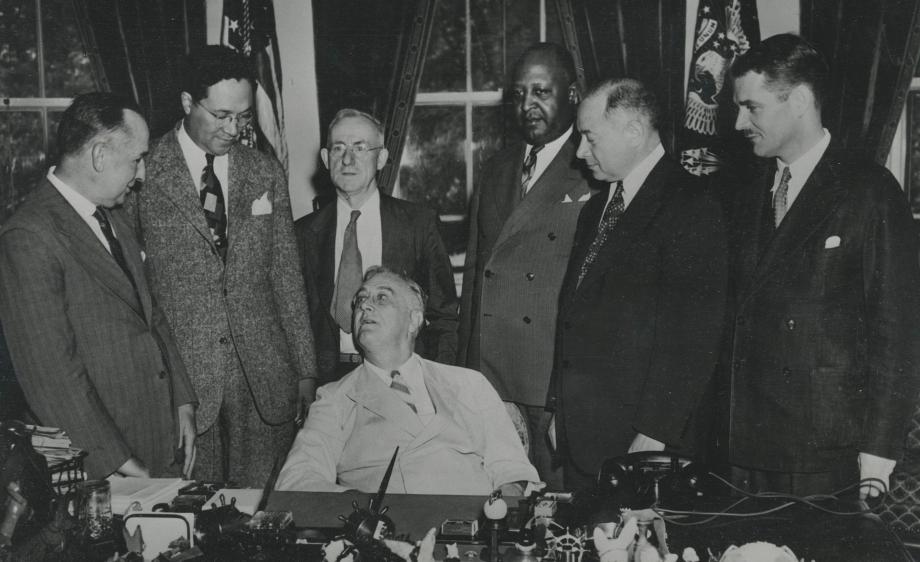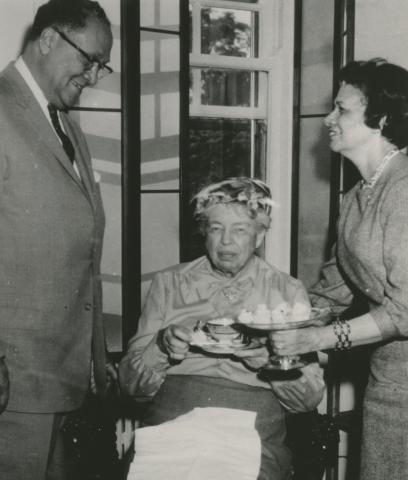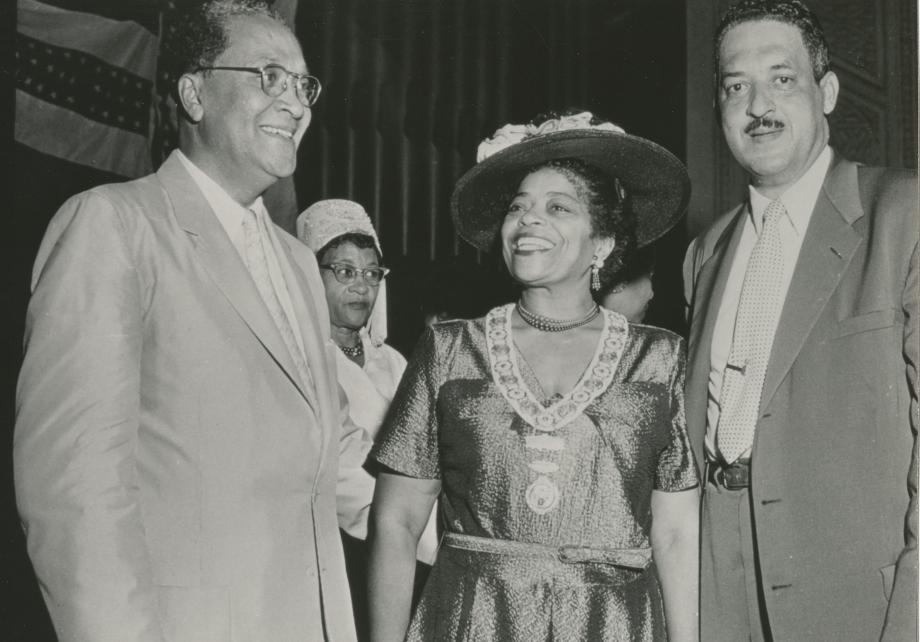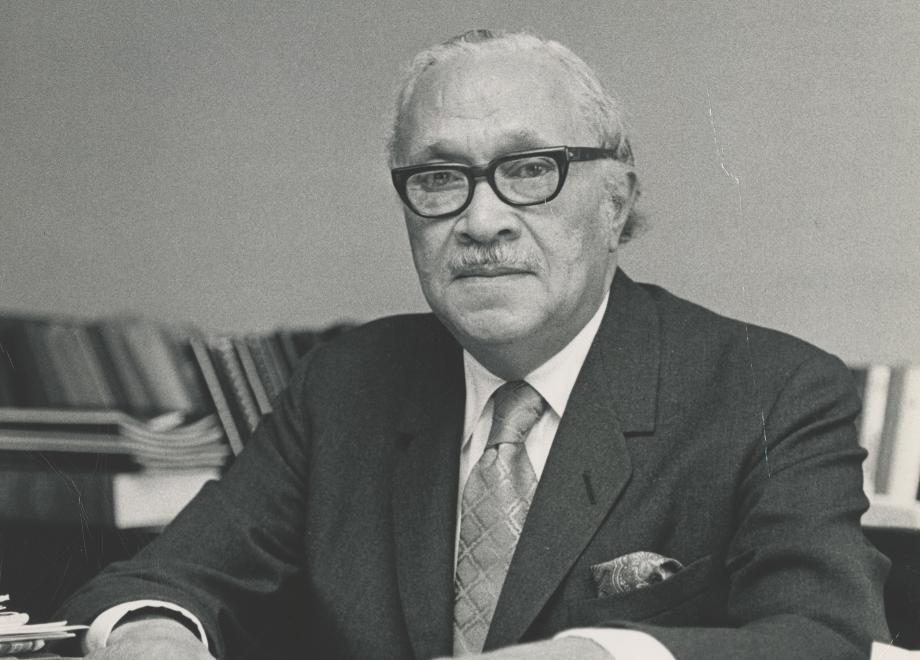A Dream Deferred, Advanced, and Remembered
Earl Dickerson Fought for Economic and Racial Justice, Argued Successfully before the Supreme Court, and Secured a Long List of “Firsts.” On the Centennial of His Graduation, the Law School Celebrates—and Reintroduces—His Legacy.
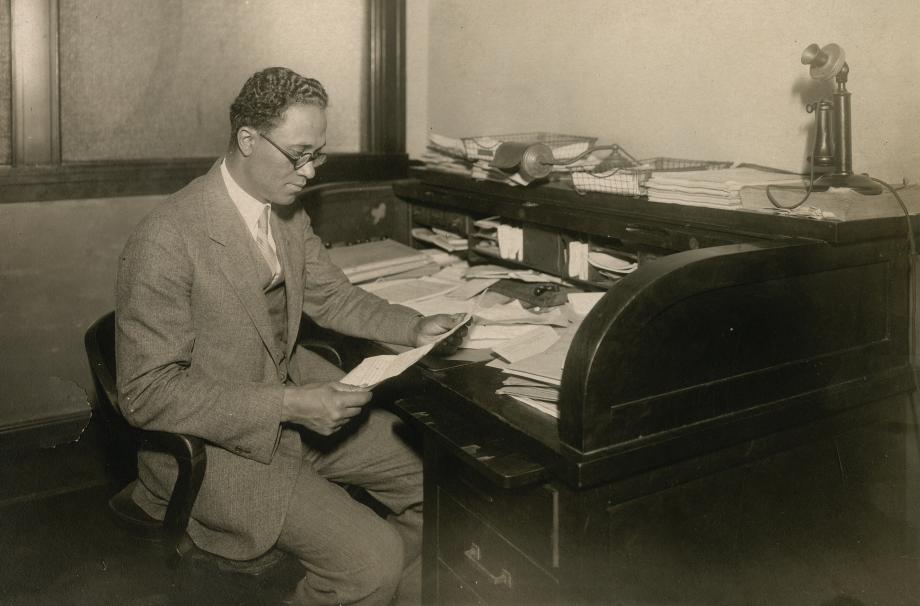
There’s a black-and-white photograph—an iconic image of Martin Luther King Jr. proclaiming “I Have a Dream” on the steps of the Lincoln Memorial—that tells an apt story about Earl Burrus Dickerson, the first African American to earn a JD from the University of Chicago.
Taken at just the right angle, the image places Dickerson within a whisper of the spotlight, a position he occupied regularly over decades of legal practice, business leadership, and public service. He isn’t the focal point; instead, he’s several bodies from the podium at the March on Washington for Jobs and Freedom, listening to King’s dream with the careful attention of a man deeply involved in both the vision and the labor sustaining it. His proximity to King hints at his stature: by 1963, Dickerson was a member of the national board of the NAACP, the president of an increasingly successful Black-owned life insurance company that had expanded economic opportunities for African Americans, and a trailblazing lawyer with both a famous Supreme Court win and several barrier-breaking milestones to his credit. He’d served on the Chicago City Council, as an assistant Illinois attorney general, and on Franklin D. Roosevelt’s Fair Employment Practices Committee. He had been the first Black president of the National Lawyers Guild, a president of the Chicago Urban League, and a president of the National Bar Association.
What the photo doesn’t say is this: Dickerson’s contributions to fair housing, fair employment, and racial justice were already intricately woven into the story of Chicago—his adopted home—and his influence on the city, the American civil rights movement, and the legal profession would be felt for decades. And despite this, 57 years later, his legacy would be a bit like the Dickerson seen in the photo, standing at the edge of history he’d helped create, barely recognizable to the majority of Americans.
“There are a lot of figures who both affect the course of history and capture the spirit of an age but are not always visible when we recite our history,” Professor William Hubbard said one day last winter in what was supposed to be the lead-up to a two-day April conference designed, in part, to nudge Dickerson’s legacy from the shadows. (The conference was ultimately rescheduled because of the COVID-19 pandemic. The first part will be held October 30, 2020, and the second is planned for April 17, 2021, when organizers hope to be able to hold at least part of it in person).
“In Earl Dickerson’s case, it could have been bias, or neglect, or that people’s attention was focused, for a variety of reasons, on more familiar names," Hubbard continued. "He did a lot of work in the ’30s and ’40s, which was a time when America collectively was preoccupied with other things—recovery from the Depression, then World War II—and it may be that circumstances weren’t particularly favorable to him being celebrated by history.”
It was December 2019, and Hubbard had been thinking a lot about Dickerson, who died in 1986 at age 95. The centennial of Dickerson’s 1920 Law School graduation was approaching, and plans were forming to celebrate it; Hubbard had been working for months with Deputy Dean Richard McAdams and Professor from Practice Sharon Fairley, as well as a small group of students and staff. It wasn’t a simple undertaking: for someone lacking in widespread name recognition, there was an enormous amount to say about Earl Dickerson. His memory looms large in certain circles, among those with connections to him and some who are continuing his work. When he was alive, US presidents and Chicago mayors and revered civil rights activists knew and respected him; one of Harold Washington’s first acts as Chicago mayor was to declare May 1, 1983, to be Earl B. Dickerson Day.
“When we think about the history of our city, Earl Dickerson was actually front and center on a lot of the important issues,” said Fairley, a former federal prosecutor and criminal justice reform advocate.
Fairley, ’06, knew Dickerson’s name as a law student—most likely, she thinks, because she was a member of the Law School’s chapter of the Black Law Students Association, which is named for him. At the Law School, the bones of Dickerson’s story are familiar: he was a grandson of enslaved people who earned his JD here in 1920—a year after the 1919 race riots and almost three and a half decades before Brown v. Board of Education—and he argued Hansberry v. Lee, the 1940 Supreme Court case that opened up housing for African Americans in part of Chicago’s Woodlawn neighborhood and set the stage for the end of racially restrictive covenants nationwide. Dickerson’s photograph hangs in the Law School’s classroom wing, alongside photos of other Law School pioneers, like Nelson Willis, 1918, the first African American to earn an LLB, and Sophonisba Breckinridge, 1904, the first female graduate. In addition to the Earl B. Dickerson BLSA chapter, the Law School has an Earl B. Dickerson postgraduate fellowship, which is awarded each year to a promising legal scholar, and an Earl B. Dickerson student scholarship, which is given annually to a student who displays a commitment to social justice. Dickerson is discussed occasionally in class: when students study Hansberry in Civil Procedure II (the case hinged on a procedural issue) or when a professor assigns his writing, as McAdams has done in Elements of the Law with Dickerson’s chapter in the NAACP’s 1947 United Nations human rights petition, “An Appeal to the World,” which was edited by W. E. B. Du Bois.
It seemed to Hubbard, McAdams, and Fairley that the anniversary of Dickerson’s graduation presented an opportunity to shine a brighter light on Dickerson. The Law School and the broader Chicago community could consider the scope of his legacy together—his connection to Chicago’s South Side, the ways in which he combined business and law to advance civil rights, the bold vision that sometimes thwarted his political ambitions—and honor the man sometimes known as the “dean of Chicago’s Black lawyers.”
The two-day multidisciplinary event, they ultimately decided, would anchor a comprehensive Dickerson centennial—a yearlong tribute that would include a winter quarter class on the civil rights movement, funding for independent student research projects, displays of Dickerson photographs and speeches, and a variety of other lectures and events throughout 2020. Together, these pieces would offer not only a look back at history but a chance to reflect on the present.
“Earl Dickerson’s story is about persistence and tenacity, about not accepting the status quo—and his example is an opportunity to understand how leaders really make change in the world using the law,” Fairley said.
The organizers decided to begin the conference with a day of academic presentations by professors of law, political science, and history, each examining different aspects of Dickerson’s life from his formative years to his work in business, government, and the civil rights movement. The second day, portions of which would be held in the auditorium, would focus on his enduring influence, featuring panel discussions on cause lawyering and fair housing, as well as remembrances from those who knew him, including his grandchildren and UChicago Distinguished Visiting Fellow and former White House advisor Valerie Jarrett, a South Side native who grew up calling Dickerson “Uncle Earl.”
The day would culminate in two theatrical readings, led by Ron O. J. Parson, director and resident artist at the UChicago-affiliated Court Theater. There would be selections from A Raisin in the Sun, the acclaimed 1959 Broadway play by Lorraine Hansberry based loosely on her family’s involvement in Hansberry v. Lee, and a recitation of the Langston Hughes poem “Harlem,” which gave the play its title. (“What happens to a dream deferred? / Does it dry up / like a raisin in the sun?”)
It was important to the organizers to connect with a variety of audiences and offer multiple avenues of engagement. After all, it may well be the sheer breadth of Dickerson’s legacy that made it so difficult for history to place him.
“Dickerson is someone who did so many different things that it’s hard to point to just one thing and say, ‘Well, we know him because of this,’” said McAdams, the Bernard D. Meltzer Professor of Law.
Of course, if there was one thing, McAdams said, it would be the Hansberry case, which Dickerson not only argued but helped engineer. As the general counsel of Supreme Liberty Life Insurance Company, where he worked nearly his entire career, Dickerson had advocated for the mortgage loan that allowed Carl Hansberry (Lorraine’s father) to buy a house in a subdivision in Chicago’s Woodlawn neighborhood—just blocks from the University of Chicago—despite the restrictive covenant intended to keep African Americans out. Supreme Liberty (as it was then called) lent the money, Hansberry bought the property and moved in, and the Woodlawn Property Owners Association predictably fought the sale. The case ultimately landed before the US Supreme Court, and Dickerson, representing Supreme Liberty, argued it. The Court’s ruling set the stage for the 1948 landmark case Shelley v. Kraemer, which put an end to restrictive covenants.
“It was impressive,” McAdams said. “A lot of lawyers work their whole careers and would love to have one case in front of the Supreme Court and would love to win that case.”
McAdams shook his head slightly.
“It’s just that it wasn’t the only thing he did,” he said. “Several things Dickerson did were equally amazing.”
***
Dickerson was a man who pushed forward, even in the face of overwhelming challenge.
By various accounts, he was elegant, meticulous, and resilient but with a fiery edge and a vision so bold that he was sometimes labeled difficult. His quarrels, however, were often ideological rather than personal, the journalist Robert J. Blakely wrote in the 2006 book Earl B. Dickerson: A Voice for Freedom and Equality, a biography that began as an oral history project for the Hyde Park Historical Society and was published more than a decade after the author’s death and two decades after Dickerson’s.
“He had a cultivated capacity . . . to be immune to the poisons of resentment,” wrote Blakely, whose research included 38 taped interviews with Dickerson, as well as interviews with 39 others.
Dickerson’s outrage was trained, instead, on the pervasive racial injustice he’d experienced and witnessed both in the South and, later, in Chicago—and this fueled his work.
Born in Canton, Mississippi, in 1891, Dickerson fled to Chicago in 1907, his mother paying railroad porters to help him stow away. “No rule of law protected us from the avarice, cruelty, and hatred of whites,” he wrote to Law School Dean Gerhard Casper nearly 80 years later, recounting his childhood in Canton.
Dickerson worked his way through high school (at the University of Chicago Laboratory Schools and later at the now-defunct Evanston Academy) and college, studying for a year at Northwestern and ultimately earning a bachelor’s degree from the University of Illinois at Urbana-Champaign. His academic success convinced him that law school was a viable option—and the best way to fight for equal opportunity, justice, and freedom.
And so, in 1915, he started at the University of Chicago Law School, leaving during his second year to serve as an officer in the US Army during World War I and returning in the spring of 1919. Months later, racial tensions on Chicago’s South Side blossomed into violence, leaving 38 people dead.
“That fall, when he walked from his apartment to the school, he carried his service revolver under his jacket because of the risks he faced on the way,” McAdams said. “I think about that, him walking all those blocks just after the riots.”
So does Adam Hassanein, ’21, one of the students on the centennial committee.
“Imagine getting an education in a segregated city where crowds of people don’t want you there, and where people are dying in race riots, and still you make the journey down to law school every day,” said Hassanein, the vice president of BLSA.
Dickerson excelled at the Law School, so much so that he was among nine students that Dean James Parker Hall recommended to three major Chicago law firms. All three firms offered Dickerson “courteous interviews”—and then rejected him, Dickerson recounted in the 1985 letter to Casper, in which Dickerson explained both his dedication to the law and his decision to endow a scholarship at the Law School.
“They were all ‘terribly sorry,’ but they all concluded that their ‘clientele would not approve of their employing a black attorney,’” Dickerson wrote. “Some of the [others] who were recommended—all white—were employed. Several became very wealthy and expressed their indebtedness to the University of Chicago Law School by gifts and endowments. My indebtedness to the University of Chicago Law School, while less than theirs in tangible ways, is probably greater than theirs in intangible ways of inspiration and preparation for the high causes to which I committed myself.”
Those high causes were many. Dickerson was among the first African Americans to join the Chicago Bar Association, and he worked to open the Illinois Bar Association up to Black lawyers. He led the Black-organized National Bar Association and Black-organized Cook County Bar Association and became the first African American to lead an integrated national bar association when he became the president of the National Lawyers Guild in 1951. (During this time, he defended the Guild against McCarthyism, waging a successful protest against the US attorney general’s contention that it was a subversive organization.) He was active in the NAACP, both in Chicago and nationally, and served on the national board for three decades. In 1926 was appointed as chair of the Chicago chapter’s Legal Redress Committee, where he led fights against restrictive covenants (including in the Hansberry case), police brutality, and other inequities. Dickerson even helped establish the Burr Oak Cemetery, the African American cemetery in which he is now buried.
He also worked in government and politics, serving as assistant corporation counsel for the city of Chicago, assistant Illinois attorney general, and beginning in 1939, as the Chicago City Council’s first Democratic Black alderman. Representing Chicago’s Second Ward (then located on the South Side), he succeeded in increasing funding for Black schools, convincing the Chicago mayor to appoint the first African American to the Chicago Board of Education, and forcing Chicago’s bus system to eliminate discriminatory hiring practices.
But he faced a variety of challenges in his government roles. He failed to win reelection to the city council in 1943 and lost three bids for US Congress in the 1940s. In 1941, President Franklin D. Roosevelt appointed him to the first Fair Employment Practices Committee, and Dickerson chaired public hearings that revealed discrimination in government and defense contracting. But despite his accomplishments on the committee, when Roosevelt formed a second FEPC in 1943, he didn’t reappoint Dickerson.
“Dickerson was active and influential in so many areas, but those efforts were often blocked or undermined by others who were more powerful,” Hubbard said.
But these were not his only avenues of change. Dickerson was driven by the idea that economic opportunity was a key to racial equality—and business offered him perhaps his strongest tool.
After the three law firm rejections in 1920, Dickerson had opened his own law firm—but he also had taken a job as general counsel of what was then named the Liberty Life Insurance Company. The company—which changed its named to Supreme Liberty Life Insurance Company and then Supreme Life Insurance Company of America—grew into one of the largest Black-owned insurance companies in the nation. Dickerson spent much of his career there, becoming president and CEO in 1955 and overseeing several profitable mergers. Supreme Life’s social mission aligned with Dickerson’s belief in the essential role of economic opportunity; the company was a source of both jobs and loans for the Black community.
“Earl’s greatest accomplishment—and it was a phenomenal one—was the building of Supreme Life,” Paul Berger, the organizer of the Hyde Park Savings and Loan Association, told Blakely in a 1983 interview. “He recognized early that for the achievement by blacks, or anybody, of any degree of real freedom, they had to have some degree of economic freedom.”
Of course, for all of his decades of work at Supreme Life, there was one loan in particular that stood out, and it went to a man named Carl Hansberry.
***
Dickerson’s role in Hansberry v. Lee was, in many ways, an early example of what we now call corporate social responsibility, says Hubbard, who teaches the case in his Civil Procedure II class.
“He didn’t see a strict separation between his role as an activist or his role as a lawyer or his role as a businessperson,” he said.
Dickerson knew the Woodlawn Property Owners Association would try to block Carl Hansberry from buying the property at 6140 South Rhodes Avenue, which is about a 15-minute walk from the Law School’s current location. The property was covered by a racially restrictive covenant that had been enforced in an earlier case, Burke v. Kleiman. Supreme Liberty’s other officers worried about being sued and losing money, but Dickerson “eventually persuaded the company that the risk was consistent with its social goals and, in addition, that the chances of winning the suit were good,” Blakely wrote in the Dickerson biography.
The property owners association reacted as expected after Hansberry moved in and filed suit for an injunction—and a judge ordered Hansberry out. Dickerson, the general counsel of Supreme Liberty and the chair of the Chicago NAACP’s Legal Redress Committee, represented Supreme Liberty and a company officer who had also purchased property in the area. Three other Law School graduates were also members of the legal team defending against the suit: Truman K. Gibson Jr., ’35; Irvin C. Mollison, ’23; and Loring B. Moore, ’23. C. Francis Stradford—the father of Jewel Stradford Lafontant, ’46, the Law School’s first Black female graduate—represented Hansberry.
When the case arrived at the Supreme Court, Dickerson delivered the oral argument.
The legal team’s strategy—arguing the case primarily on what seemed like a technicality—is one that intrigues Hubbard. The lower courts had allowed the covenant to stand on the grounds that it was res judicata (already decided) by Burke v. Kleiman, an Illinois state court judgment that held that the covenant was valid because it had been signed by 95 percent of landowners in the neighborhood. But Dickerson convinced the Court that Burke v. Kleiman did not bind the parties to the current case, because their interests had not been “adequately represented” in the earlier case. Thus, Burke v. Kleiman did not control, and the validity of the covenant remained an open question. Dickerson then showed that the covenant wasn’t enforceable even under its own terms, because it hadn’t been properly ratified by the property owners association. Although the covenant required signatures from owners of 95 percent of the land in the neighborhood, in fact the true percentage was far lower.
The question of whether the covenant itself was constitutional was a secondary issue.
“There can be deep divisions among activists about strategy—whether to be incrementalist or whether to be bold, and that sort of played out in Hansberry,” Hubbard said. “With his activism, Dickerson tended to fall on the side of being bolder and more aggressive, but here the narrower strategy was the winning strategy. In 1940, the Supreme Court did not seem ready to make a sweeping statement about the constitutionality of racially restrictive covenants. It would be another eight years before the Court struck down racially restrictive covenants as unconstitutional.”
Despite the narrow ruling, the Hansberry case made a section of Woodlawn available to African Americans. It offered the first real victory against restrictive covenants, though the fight to open the rest of the South Side—outside of the “Black Belt” area to which African Americans were limited—would remain a difficult one. (It should be noted that Dickerson and his family pushed out of the Black Belt themselves, and in 1949 became the first African Americans to live in Hyde Park since before World War I.)
Dickerson’s willingness to take a risk in advocating for the Hansberry loan—and his commitment to the company’s social mission—offer enduring lessons about leadership and change, Fairley said.
“Activism isn’t necessarily about getting out on the street and protesting and raising signs. You can be a corporate lawyer and be an activist at the same time,” she said. “We can all be activists in the context of the work we do or the lives we live. Earl Dickerson is a perfect example of that.”
***
Early in 2020, 80 years after the Hansberry decision, Hassanein found himself thinking about Dickerson’s style of activism. A few months earlier, he’d met with one of Dickerson’s grandsons, who had shown him the photo of Dickerson on the steps of the Lincoln Memorial in 1963, listening to King’s “I Have a Dream” speech. The grandson, Steve Brown, hadn’t known Dickerson had attended the March on Washington until well after Dickerson’s death; his grandfather had never mentioned it to him.
Hassanein, of course, had seen images from that day, but he’d never seen—or looked for—Earl Dickerson before.
“You expand [the angle] out and you see Earl Dickerson, who’s just five, maybe 10, feet away from King,” Hassanein said.
It was a reminder, he added, that even if he wasn’t always visible, Dickerson was right there and “involved in so many things.”
That breadth of effort—and the tirelessness that accompanied it—were, perhaps, his defining traits.
“No man I have ever known has been as consistent as Mr. Dickerson in fighting for truth, equality, and fair play,” Jet/Ebony publisher John H. Johnson, chairman of the Supreme Life Insurance Co., said in Dickerson’s obituary in Jet magazine in 1986. “He has done it with dignity, with integrity, and with style and elegance.”
In the foreword to the Blakely biography, John Hope Franklin, a prominent African American history professor who taught at UChicago in the mid-1960s, wrote about Dickerson’s advocacy, charm, and ability to garner respect.
“I would put him right up there with the great people we think about such as Thurgood Marshall and others who functioned within the courts at federal levels,” Franklin wrote. “Earl’s activities were focused on Chicago. His impact on Chicago was immense.”
Hassanein thinks about the “pervasive strength” that must have fueled Dickerson’s relentless drive, and he hopes that the Law School’s centennial celebration will “breathe new life” into Dickerson’s legacy.
“He was instrumental in so many different events in history and the civil rights movement and governing and in the legal profession,” Hassanein said.
Dickerson, he concluded, “was someone who got the work done as opposed to saying, ‘Look what I’ve done.’ He just had that drive and that passion and that desire to make change. I think it’s such a compelling story of resilience—and one that carried through his entire career.”
About the March on Washington Photo
The photograph of Earl B. Dickerson listening to Martin Luther King Jr.’s “I Have a Dream” speech was taken by a Johnson Publishing Company photographer on August 28, 1963, and appears in The Day They Marched, a book released by Johnson Publishing that same year. The company, the Chicago-based former owner of Ebony and Jet magazines, filed for Chapter 7 bankruptcy last year. In July, the J. Paul Getty Trust, the Ford Foundation, the John D. and Catherine T. MacArthur Foundation, and the Andrew W. Mellon Foundation purchased their archives for $30 million. They plan to donate the collection, which includes millions of photos and thousands of hours of audio and video recordings, to the Smithsonian’s Museum of African American History and Culture and the Getty Research Institute. At press time, the recently acquired collection was unavailable but was believed to contain this photo.
But there’s more to the story behind our search for its origins—one that includes an 88-year-old civil rights activist from New Jersey, a San Francisco publicist who helped organize buses for the March on Washington, a Canadian political blogger, a Dickerson grandson, and a Dickerson protégé.
When Dickerson’s grandson Steve Brown shared the photo with us, he knew only that a family member had found it online. We turned to Google, and a reverse image search revealed three people with ties to it. The first was Arnold E. Brown (no relation to Steve), a civil rights activist who didn’t know Dickerson well but stood near him during King’s speech. He appears in the photo and has a framed copy of it hanging in his Bergen County, New Jersey, home. His copy is visible in photos that appeared in his local newspaper two years ago, when he was honored for his work preserving the history of African Americans in northern New Jersey. Brown, we learned, is a past president of his local chapters of the NAACP and the Urban League and was the first African American from Bergen County elected to the state’s General Assembly. Brown said someone gave him the March on Washington photo in the 1960s, and many years later, US Congressman John Lewis—the youngest of the “Big Six” who led the March on Washington—signed it. But when we spoke to Brown, he said he didn’t know who took the photo.
So we tried our next lead, a man in San Francisco named Michael Nolan, a Brooklyn native who attended the March on Washington when he was a senior at New York’s Columbia University. Nolan had volunteered for march organizer Bayard Rustin—and when King delivered his speech, Nolan was standing in the audience facing seated VIPs like Sammy Davis Jr. and Charlton Heston. As a result, Nolan isn’t in this photo, and when we swapped messages on Pinterest and later by email, he, too, said he wasn’t sure who’d taken it.
Our third and final shot was Canadian political activist Michael Laxer, who found the photo several years ago in a book and shared it on The Left Chapter, his socialist blog. Problem was, he couldn’t remember which book. He was willing to search his vast collection, though—and he spent hours flipping through pages until he found the photo on page 54 of The Day They Marched.
His discovery brought us right back to Chicago—and, indirectly, to Earl B. Dickerson, who had mentored Johnson Publishing Company founder John H. Johnson.
Johnson, who died in 2005, knew Dickerson for decades: He was Dickerson’s political secretary during Dickerson’s time on the Chicago City Council and, before launching the magazines, worked in the office of Supreme Life (which then went by a different name). Later, Johnson served on Supreme Life’s board, and in 1971 succeeded Dickerson as president and CEO. An editor’s note thanks Johnson for setting the tone for The Day They Marched, and for his efforts in helping assemble the photos from the company’s archives. The book lists 11 photographers, but does not credit the photos individually.
We offer our deep thanks to Steve Brown, Arnold Brown, Michael Nolan, and Michael Laxer, not only for their help, but for the stories they shared along the way.
